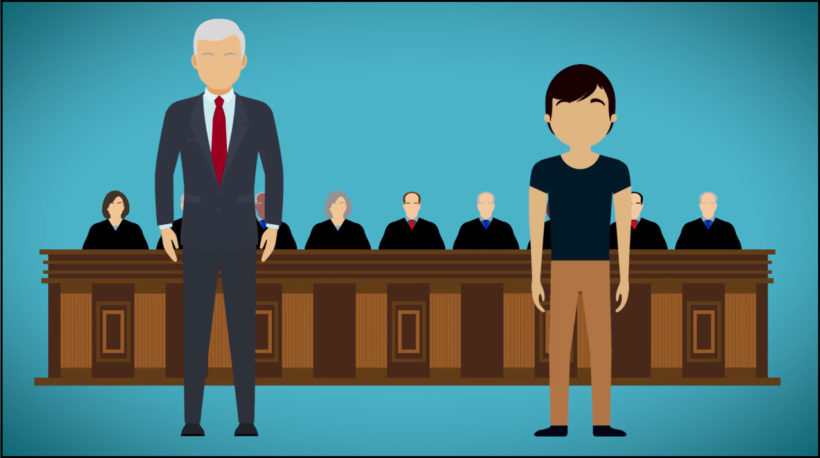
redo Jump to...
print Print...
(by Andrew Chung, Reuters) WASHINGTON – U.S. Supreme Court justices on Monday expressed skepticism toward part of an immigration law requiring the deportation of immigrants who commit violent felonies because of uncertainty over which crimes fit the bill and which do not.
The justices heard arguments in the government’s appeal of a lower court’s ruling that language in the Immigration and Nationality Act calling for deportation of legal immigrants convicted of a “crime of violence” was so vague that it violated their rights to due process of law under the U.S. Constitution.
The case involves a Filipino legal immigrant named James Garcia Dimaya who federal authorities ordered deported after he was convicted in two California home burglaries, though neither crime involved violence.
…The ruling in the case could help clarify the crimes for which non-citizen immigrants may be expelled, affecting the Trump administration’s policy of stepping up the removal those with criminal records. …
Monday’s arguments marked the second time the court has tried to tackle the case. It heard arguments in January when the nine-seat court was one justice short [following the death of Justice Antonin Scalia], then decided in June to have the case re-argued this term after Conservative Justice Neil Gorsuch [was confirmed]. …..
Dimaya came to the United States from the Philippines as a legal permanent resident in 1992 at age 13. He lived with his family in the San Francisco Bay area, and had worked in several retail store jobs, including as a manager.
He was convicted in residential burglaries in 2007 and 2009 in crimes in which no violence was used and no one was injured. For each conviction he was sentenced to two years in prison.
In 2010, the Obama administration began a process to deport Dimaya. The Justice Department’s Board of Immigration Appeals, the highest U.S. administrative body for interpreting and applying immigration laws, refused to cancel his expulsion because the law involved defines burglary as a “crime of violence.”
In the federal criminal code, a “crime of violence” includes offenses in which force either was used or carried a “substantial risk” that it would be used.
The San Francisco-based liberal 9th U.S. Circuit Court of Appeals ruled in 2015 that the definition as applied to non-citizen immigrants was unconstitutionally vague and can lead to arbitrary enforcement of the law. The appeals court relied on a decision that same year by the U.S. Supreme Court in a different case, which found that a similar provision in a federal criminal sentencing law was overly broad.
The 7th Circuit Court in Chicago handed down a similar ruling to the 9th Circuit, while the 5th Circuit in New Orleans ruled in favor of the government.
The split prompted the high court to decide the case of Lynch vs. Dimaya. By the time the decision is handed down, the case will probably be relabeled Sessions vs. Dimaya, to reflect expected change of attorney general. [President Obama’s Attorney General was Loretta Lynch; President Trump’s Attorney General is Jeff Sessions.]
The case was argued on Monday, the first day of the court’s new term. A ruling is due by the end of June.
From Reuters .com. Reprinted here for educational purposes only. May not be reproduced on other websites without permission from Thomson Reuters.
Questions
NOTE TO STUDENTS: Before answering the questions, read the “Background” and watch the video under “Resources” below the questions.
1. a) How many justices are on the U.S. Supreme Court?
b) Who is the Chief Justice?
c) List the other justices.
2. Regarding the case:
a) What status does James Garcia Dimaya have? When did he come to the U.S.?
b) What crimes was Mr. Dimaya convicted of committing? What sentence did he receive for each crime?
c) When/why did the Obama administration begin deportation process for Dimaya?
d) Why did the Justice Department’s Board of Immigration Appeals, the highest U.S. administrative body for interpreting and applying immigration laws, refuse to cancel his expulsion proceeding?
3. How does the federal criminal code describe a “crime of violence”?
4. How did the San Francisco-based liberal 9th U.S. Circuit Court of Appeals rule on the case in 2015?
5. When will the justices hand down their ruling on the case?
CHALLENGE: Do an internet search to find out the specific details of Mr. Dimaya’s crimes. There should be many news reports detailing the case as this will be a very significant decision.
Background
On the Supreme Court from BensGuide.gpo.gov:
- Approximately 7,500 cases are sent to the Supreme Court each year. Out of these, only 80 to 100 are actually heard by the Supreme Court. When a case comes to the Supreme Court, several things happen. First, the Justices get together to decide if a case is worthy of being brought before the Court. In other words, does the case really involve Constitutional or federal law? Secondly, a Supreme Court ruling can affect the outcome of hundreds or even thousands of cases in lower courts around the country. Therefore, the Court tries to use this enormous power only when a case presents a pressing constitutional issue. …
- The Supreme Court convenes, or meets, the first Monday in October. It stays in session usually until late June of the next year. When they are not hearing cases, the Justices do legal research and write opinions. On Fridays, they meet in private (in “conference”) to discuss cases they’ve heard and to vote on them. …
- Most cases do not start in the Supreme Court. Usually cases are first brought in front of lower (state or federal) courts. Each disputing party is made up of a petitioner and a respondent.
- Once the lower court makes a decisions, if the losing party does not think that justice was served, s/he may appeal the case, or bring it to a higher court. In the state court system, these higher courts are called appellate courts. In the federal court system, the lower courts are called United States District Courts and the higher courts are called United States Courts of Appeals.
- If the higher court’s ruling disagrees with the lower court’s ruling, the original decision is overturned. If the higher court’s ruling agrees with the lower court’s decision, then the losing party may ask that the case be taken to the Supreme Court. But … only cases involving federal or Constitutional law are brought to the highest court in the land.
EXPLANATION OF PROCEDURE FOR ORAL ARGUMENTS IN THE SUPREME COURT:
(from supremecourt.gov/visiting/visitorsguidetooralargument.aspx)
- A case selected for argument usually involves interpretations of the U. S. Constitution or federal law. At least four Justices have selected the case as being of such importance that the Supreme Court must resolve the legal issues.
- An attorney for each side of a case will have an opportunity to make a presentation to the Court and answer questions posed by the Justices. Prior to the argument each side has submitted a legal brief – a written legal argument outlining each party’s points of law. The Justices have read these briefs prior to argument and are thoroughly familiar with the case, its facts, and the legal positions that each party is advocating.
- Beginning the first Monday in October, the Court generally hears two one-hour arguments a day, at 10 a.m. and 11 a.m., with occasional afternoon sessions scheduled as necessary. Arguments are held on Mondays, Tuesdays, and Wednesdays in two-week intervals through late April (with longer breaks during December and February). The argument calendars are posted on the Court’s Website under the “Oral Arguments” link. In the recesses between argument sessions, the Justices are busy writing opinions, deciding which cases to hear in the future, and reading the briefs for the next argument session. They grant review in approximately 100 of the more than 10,000 petitions filed with the Court each term. No one knows exactly when a decision will be handed down by the Court in an argued case, nor is there a set time period in which the Justices must reach a decision. However, all cases argued during a term of Court are decided before the summer recess begins, usually by the end of June.
- During an argument week, the Justices meet in a private conference, closed even to staff, to discuss the cases and to take a preliminary vote on each case. If the Chief Justice is in the majority on a case decision, he decides who will write the opinion. He may decide to write it himself or he may assign that duty to any other Justice in the majority. If the Chief Justice is in the minority, the Justice in the majority who has the most seniority assumes the assignment duty.
On the Role of Judges:
Judges are like umpires in baseball or referees in football or basketball. Their role is to see that the rules of court procedures are followed by both sides. Like the ump, they call ‘em as they see ‘em, according to the facts and law-without regard to which side is popular (no home field advantage), without regard to who is “favored,” without regard for what the spectators want, and without regard to whether the judge agrees with the law. (from the American Bar Asociation)
“The role of a judge is to be a neutral interpreter of already established law, not legislator of new law or social policy. A judge can have his or her own opinions, even strong ones, and still read the law neutrally. Fundamentally, judges are expected to not bring their personal politics and philosophies to the bench. Judges are expected to read the law in its clear intent and apply it without regard to result. Changing the law should be left to the people and their legislators.” Sean Rushton, Committee for Justice Executive Director, from the WashingtonPost.com.
“One of the big confusions in the…Senate fight over the confirmation of judicial nominees is that this is an issue about ‘liberal’ judges versus ‘conservative’ judges. The vastly more important issue is whether people who go into court should expect their cases to be decided on the basis of the law or on the basis of the particular judge’s own philosophy…Liberals have rooted for judicial activism because this activism has favored liberal causes and liberal views on such issues as abortion, the death penalty, gay marriage, and racial quotas. But activism can be used by any judge for any purpose.” Thomas Sowell, Hoover Institution
NOTE: …It is crucial…to have a president who understands the judiciary’s proper role. As Ronald Reagan once noted, “[The Founders] knew that the courts, like the Constitution itself, must not be liberal or conservative.” For Reagan and for the Founders, judges were to be selected based on their ability to put political preferences aside and interpret the Constitution and laws based on their original meaning. Rather than scrutinizing judicial nominees based on their perceived political leanings, [every] president should appoint judges who apply the law regardless of their own policy preferences. (from “Misunderstanding the Role of Judges” by Deborah O’Malley)
Resources
Read brief bios on the current Supreme Court justices at: supremecourt.gov/about/biographies.aspx.
Read more about the cases accepted by the Supreme Court for 2017-18 at the official website: supremecourt.gov.
Watch a 9/29/17 video explaining the case:
Daily “Answers” emails are provided for Daily News Articles, Tuesday’s World Events and Friday’s News Quiz.




